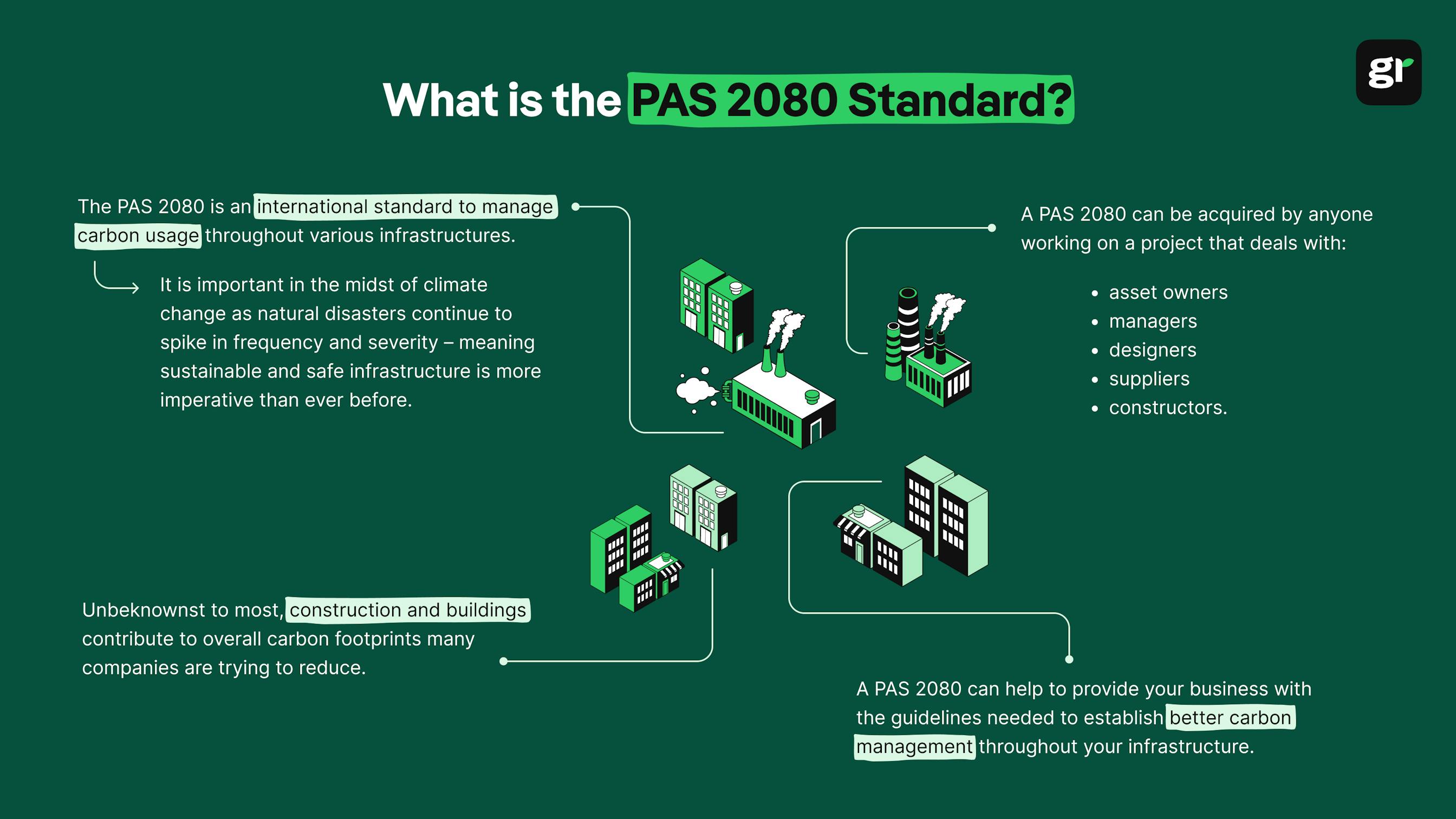
What are the 3 Pillars of Corporate Sustainability?
In this article, we'll explore what the 3 pillars of corporate responsibility are, why they're important, and how businesses can turn them into practical action.
ESG / CSR
Industries



With more and more businesses seeking to achieve net-zero emissions by 2050, many are looking for the best certifications for carbon management – which could very well be the PAS 2080.
What is the PAS 2080, and why is it a respected certification for companies seeking to establish and improve their carbon management?
The PAS 2080 is an international standard to manage carbon usage throughout various infrastructures. The PAS 2080 works to achieve this by monitoring the entire value chain and seeks to reduce carbon emissions depending on the data revealed by the value chain itself. The PAS 2080 is originally derived from a document in the U.K.’s Construction Playbook – which is being referred to more often to specify carbon management in buildings today. The carbon management standard was initially developed by the BSI, or the British Standards Institution
The PAS 2080 has recently undergone several updates, which is set to be published later this year. After the updated version of the PAS 2080 has been released, users of the current PAS 2080 will be encouraged to purchase the upgraded edition to ensure that their certification remains as efficacious as possible.
Some of the improvements made to the PAS 2080 include expansion of the standard to pertain to more existing buildings, clearly define the roles for all part of the value chain in order to control and reduce emissions more effectively, pontificate the importance of a reduced carbon footprint, further work to decarbonize various systems, implement new tactics such as climate resilience, and promote both leadership and collaboration throughout the value chain.
Given infrastructure is a massive contributor in carbon emissions, contributing to nearly half of the United Kingdom’s overall emissions – A PAS 2080 is the ultimate certification for businesses looking to receive an accreditation for their carbon management skills.
👉 The ultimate goal of the PAS 2080 is to help reduce overall carbon emissions throughout the entire industry across all value chains.
However, the PAS 2080 has a lot of idiosyncratic benefits as well. After all, the PAS 2080 Carbon Management in Infrastructure didn’t become the world’s first standard to manage carbon emissions throughout various buildings for now reason. The PAS 2080 has already proven successful in helping businesses reduce their use of carbon and the costs associated with that excessive use.

The PAS 2080 can also help an organization gain clarity on which carbon management tactics are proving most effective for their individual business, can teach them the value of consistency and how sustained measures can yield success across all sectors, come up with innovative ideas that would otherwise never come to fruition, provide a competitive advantage against competitors, and most importantly – reduce carbon emissions and help to fight against climate change.
The PAS 2080 provides companies with all of these benefits, and in addition – a new accreditation that can help influence future investors and stakeholders to take part in the project. A standard like the PAS 208 is a classic win-win approach: it helps the environment, and stimulates business success.

Similar to the ISO series, there is a PAS series where it can be easy to confuse one accreditation with the other – such as the difference between the PAS 2060 and the PAS 2080.
The difference between the PAS 2060 and the PAS 2080, is that the PAS 2060 is a standard that aims to encourage businesses to demonstrate their efforts towards carbon neutrality and establish greater transparency between their customers and potential business partners to avoid allegations like greenwashing. The PAS 2060 can assist companies to create a personalized plan on how to measure, reduce, and offset their carbon dioxide and greenhouse gas emissions.
On the other hand, the PAS 2080, while it also strives to improve transparency – is designed to help businesses manage their carbon emissions specifically throughout their infrastructure. This is done by setting strict limits on emissions to build more carbon efficient buildings for businesses.
Both the PAS 2060 and the PAS 2080 are standards that were published by the British Standards Institution – but the PAS 2060 is older and more general than the PAS 2080.
👉 The two standards both strive to reduce carbon emissions and promote greater transparency – but the PAS 2080 is more specific than the PAS 2060.

You may be wondering how buildings could be accounting for such a large percentage of a country’s carbon emissions – isn’t it human activity that’s provoking the rise in global surface temperature?
While it’s true that human activity is the newfound root cause of climate change reaching the tipping point that it has, buildings are still a fact of human activity. In other words, industrialization and work culture have created the need for these high carbon emitting buildings.
Infrastructure can impact the environment from construction to daily use. Construction of a building alone requires electricity to power the machinery necessary to build the building itself, excessive water usage, and waste.
This is why more companies are opting for modular construction – a method of building where the components of the final infrastructure are built offsite and can ultimately help to reduce building costs and increase efficiency throughout the construction process.
However, it’s also the sustainability of the building itself that produces emissions. Millions of lights people are switching on and off, heating and cooling systems running, and computers thinking absorb massive amounts of electricity. That’s why it’s important to implement green building values: like opting for LED efficient lighting and turning the heating or cooling system off when it isn’t necessary.
The PAS 2080 can help businesses determine where and how they can reduce carbon emissions throughout their infrastructure.

A PAS 2080 is no doubt beneficial for your company, but how difficult is it to acquire?
👉 Turns out, a PAS 2080 is available to anyone involved in a project pertaining to infrastructure: such as including asset owners, managers, designers, suppliers, or constructors. Anyone in any of these roles can request a PAS 2080.
First, it’s essential to understand the PAS document and how it will benefit your business. Second, those seeking a PAS 2080 can request to download the standard and test their knowledge of PAS 2080 principles to make sure that the resources can be implemented to their utmost potential.
Finally, the individual requesting the PAS 2080 can review the standard and seek to get verified through a third-party source. The length of the assessment will depend on the size and sector of the business.
Turns out, getting PAS 2080 is a lot like getting a driver’s license – study hard for a short amount of time, pass the exam, and you’re good to go!

That being said, is it essential to acquire a PAS 2080 to implement carbon management within your infrastructure and value chain?
👉 You don’t need a PAS 2080 to take a look at your value chain and start reducing your carbon emissions, but it can help provide your business with the guidelines you need to implement to establish better carbon management throughout your infrastructure.
Still, if your business isn’t ready for the responsibility of pursuing a PAS 2080 – there are still things that can be done to reduce your carbon emissions and get started on the path to acquiring a PAS 2080.
As mentioned earlier, trying to make your home or office more sustainable is key. Changing out lightbulbs, washer-dryer machines, or anything powered by electricity to be more energy efficient is a start. Opting for reusable bags and utensils to avoid the use of plastic can also help to reduce your overall carbon footprint. If new offices or houses are to be made, deciding to proceed with construction methods that mitigate excessive emissions and waste like modular construction are a good idea to ensure that the new property starts off on the right oot with sustainability in mind from the beginning.

It’s important to monitor when heating and cooling systems don’t need to be in use, or any devices that require electricity for that matter. For instance, when you leave your home for vacation or everyone is out of the office during Thanksgiving – shut off the power grid if possible.
These little actions can help companies work towards greater carbon reduction goals and value chain efficiency, and ultimately – help them to acquire a PAS 2080 certification.
It may seem like a lot of paperwork to apply for a PAS 2080, but the potential benefits of reducing carbon emissions and operational costs could help businesses in the long run.
Investors are starting to become most interested in financially contributing to businesses that depict their environmental values. Whether that be through an ISO 14001, joining Agenda 2030, or being dedicated to achieving net-zero emissions by 2050 – investors and stakeholders alike are more likely to partner up with businesses that are transparent. Companies that acquire a PAS 2080 are able to illustrate both their dedication towards reducing carbon emissions throughout infrastructure, an efficient value chain, and overall transparency.
Think of acquiring a PAS 2080 as someone applying for a job. While one could list all of the reasons why they are qualified and competent to do the task at hand, it’s faster to determine if they might possess the appropriate skills if they already have an applicable qualification – like previous work experience or a degree. The PAS 2080 can be viewed as a degree for companies, so that they can easily demonstrate their carbon reduction efforts to potential business partners.

Infrastructure and value chain are two massive contributors to the carbon emissions that your company is responsible for on a daily basis. You could opt to manage it alone, or with the guidance and rigor that a PAS 2080 standard provides your company with. The choice is yours, but if you’re serious about climate change – a PAS 2080 is no doubt worth it in the long run.
If reading this article the PAS 2080 standard has made you interested in reducing your carbon emissions to further fight against climate change – Greenly can help you!
Greenly can help you make an environmental change for the better, starting with a carbon footprint assessment to know how much carbon emissions your company produces.
Click here to learn more about Greenly and how we can help you reduce your carbon footprint.